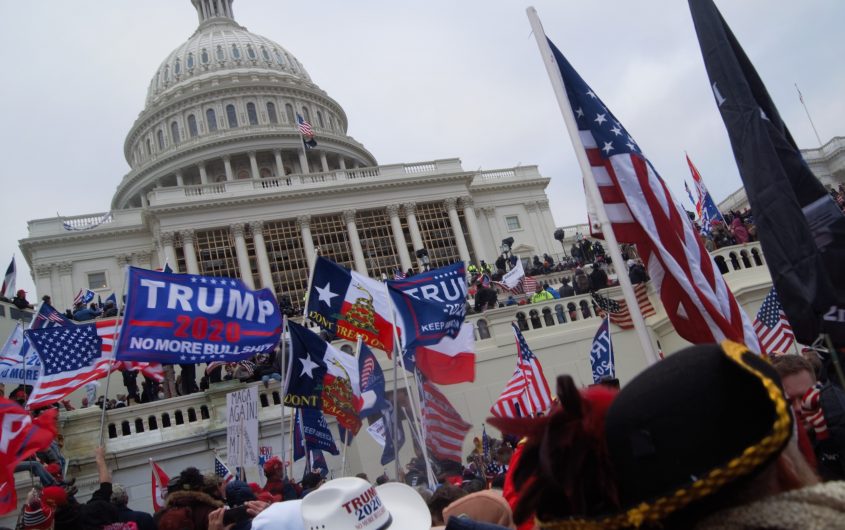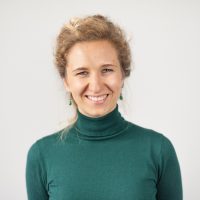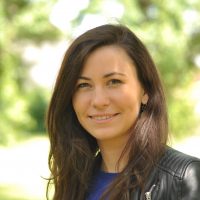
Tyler Merbler via Flickr
Transatlantic Convergence or Divergence? QAnon after January Twentieth

Elizaveta Firsova
Institute for Didactics of Democracy
Elizaveta Firsova is a research associate and PhD student at the Institute for Didactics of Democracy at Leibniz University of Hanover. Ms. Firsova holds a Master of Arts in Education Studies from Freie Universität Berlin and has focused on the role of education in combatting social division, especially regarding immigrant communities. After her graduation, she worked for "PROOF: Media for Social Justice" in New York City, on curricula in the field of social justice. Currently, Ms. Firsova is a project coordinator for initiatives funded by the European Union to tackle social divisions on different levels. In one project, she focuses on bringing digital media literacy to schools with predominantly disadvantaged students, and in her second project, she is designing a program to target extremism and conspiracy theories in adult education institutions. In her PhD thesis, Ms. Firsova researches the impact of the Israeli-German youth exchange program on participants' political views regarding the Israeli-Palestinian conflict.

Teresa Eder
Program Director, Heinrich Böll Foundation Washington, DC
Teresa Eder joined the Heinrich Böll Foundation in 2022 and heads the program for Foreign & Security Policy in Washington, DC. The program focuses on strengthening transatlantic exchanges on issues of global peace & security, democracy, and human rights.
Previously, Teresa was a program associate at the Wilson Center’s Global Europe Program and worked as a journalist and TV-news producer for German TV ARD and ZDF in Washington, D.C., and as Deputy Head of the Foreign Desk for the Austrian newspaper “Der Standard” in Vienna. Her producing, writing, and research focused on transatlantic relations, political division, and issues of extremism & disinformation in the United States and Europe.
She holds a Master’s degree in International Relations from Georgetown University’s School of Foreign Service, a Master’s degree in Political Science from the University of Vienna, and a journalism degree from the University of Applied Sciences in Vienna.
With President Donald J. Trump leaving the Oval Office, a major tenet of the QAnon movement has been proven wrong: On January twentieth, the day of Joe Biden’s presidential inauguration, there were no mass arrests of Democrats, no enactment of martial law, and no “Great Awakening.” Prophecies of President Trump holding the “deep state” accountable didn’t come to pass, and the attempt to falsify the election results fell short.
The last few weeks have seen increased scrutiny of QAnon followers—and for good reason. Not only were many of them on the front lines of the Capitol Riot on January sixth, but the movement also grew by leaps and bounds in 2020. History suggests that conspiracy movements, like viruses, are more likely to mutate and evolve, rather than disappear entirely. The key questions now are twofold: what are the most likely vectors of the QAnon movement post-Trump, and can democracies inoculate the majority of their citizens before new variants emerge and infect more of their populations?
QAnon will likely take unexpected turns and push new narratives, depending on the local context. Although the Q-conspiracy theory originated in the United States, it is worth underscoring that its appeal is global—from Japan to Brazil, countless citizens have gone down the rabbit hole and show no signs of breaking away from QAnon. Still, January 20th will have different consequences for American QAnon believers and their German counterparts. The following analysis aims to highlight the different expressions of QAnon and possible trajectories based on what research suggests about conspiratorial thinking.
The future of QAnon in Germany
In the wake of the Coronavirus pandemic, the QAnon movement has swept from the United States to Germany. Today, Germany has the highest number of Q-followers and sympathizers outside the United States, according to the anti-racist advocacy group HOPE not hate. In the last year, membership in German QAnon-Telegram channels has increased more than sixfold—from around 20,000 to 122,000 subscribers. While not every subscriber of a QAnon channel may identify as a Q-follower in the strict sense, a closer look at the German-language Telegram group “Q PATRIOTEN 24!!!” shows that roughly half of the group members also actively participate in “Q-friendly” chat discussions.
The topics discussed in German QAnon groups focus heavily on U.S. politics and echo American narratives about President Trump’s grandeur, the Democratic Party’s corruption, the treason of Mike Pence and Nancy Pelosi, and Joe Biden’s supposedly illegitimate presidency. A lot of the German group members celebrated the Capitol Riot as a victory for the Q-movement. If there is talk of Germany, the coronavirus crisis is front and center. Most narratives revolve around the government manipulating the masses in its attempts to curb the spread of the coronavirus. Recently, vaccination efforts have attracted attention, usually framed as forced and deadly attacks on the population. Sharing disinformation about vaccination incidents where people experienced complications or passed away, devoid of the necessary context, has become a staple of active Q-group members.
A striking feature of the German Q-movement is its overlap with other groups that have formed during the pandemic. Much of the QAnon content in Germany is shared across channels, originating from the telegram groups of Querdenken or Widerstand 2020 (two of the most organized Corona-skeptical movements in Germany). The QAnon movement seems to benefit from its flexibility and vagueness, enabling followers to integrate topics that are also promoted in other—often far-right—groups. Ideologically, there is a visible connection to right-wing extremist groups, such as the “Reichsbürgerbewegung,” and right-wing extremist public figures, such as conspiracy theorists Attila Hildman and Eva Herman.
In the case of the QAnon movement, sympathizers with a “conspiracy mentality” can easily integrate original QAnon narratives and other conspiracy theories.
However, synergies between QAnon and other right-wing conspiracy theorists are hardly a new phenomenon. The anti-lockdown demonstrations in 2020 featured a number of protesters waving imperial flags (symbol of right-wing extremist groups), which also included visible references to the letter Q. Another striking resemblance to Germany’s “Reichsbürger” movement is an obsession with prepping: hoarding weapons and food to be prepared for the collapse of “the system,” which believers expect to happen any day now. Further obvious connecting elements between the QAnon and the “Reichsbürger” movements are anti-Semitic narratives of the ongoing “Jewish world conspiracy,” the narrative of the state as the enemy of the people, and fervent hopes for regaining “true” national sovereignty.
This theoretical flexibility that combines seemingly unrelated elements of various conspiracy theories is referred to as “conspiracy mentality.” Psychologists consider it a stable personality attribution or trait. A manifest “conspiracy mentality” leads to changes in thought processes and frames of understanding the world, enabling an individual to see plausible connections between even unrelated conspiracy theories. In the case of the QAnon movement, sympathizers with a “conspiracy mentality” can easily integrate original QAnon narratives and other conspiracy theories. This mentality serves as the productive driver of an ever denser, albeit not necessarily more logical, web of conspiracy theories.[1]
As of now, there is no indication that QAnon might disappear from the German stage altogether.
Despite “Q’s” silence since December 8, 2020, the German QAnon groups remain active, primarily focusing on the coronavirus pandemic and the related topics. After the Capitol riots, the German Bundesamt für Verfassungsschutz (the domestic intelligence service of the Federal Republic of Germany) started targeting the movement and paying attention to the development within the German Q-groups. Despite the many false predictions about the U.S. election, QAnon’s popularity hasn’t waned. The movement’s conceptual flexibility increases its chances to latch on to older or new conspiracy theory groups.
As of now, there is no indication that QAnon might disappear from the German stage altogether. In fact, QAnon is only the most recent in a long line of “awakening” movements, which have demonstrated remarkable resilience to false prophecies. When looking back at other conspiracy-driven movements and cults, parallels can be drawn to Jehovah’s Witnesses who predicted Judgment Day three times (1874, 1914, and 1925). Each time, they proclaimed that all infidels were to be wiped from the face of the earth. Judgement Day, however, never came.
Notwithstanding these false prophecies, the movement did not experience a massive decline in membership and quietly decided to keep the date of Judgment Day flexible. This example illustrates a basic principle: the more ideologically committed a movement is in a particular cause or prophecy, the more unlikely it is to change course, even in the face of logical flaws and otherwise fatal setbacks.[2]
The future of QAnon in the United States
The role of President Trump as a martyr holds more significance for American QAnon followers than for German QAnon followers. Trump has been labeled as the inadvertent “cult leader” of QAnon, although he does not direct the conspiracy theory. As a consequence, Trump’s behavior and actions in the future will shape the direction of the QAnon movement. While Trump (and Q himself) has been quiet for the last weeks, it does seem likely that the former president will seek to gain exposure through a new platform. It remains to be seen whether Trump will pursue his public “comeback” by commandeering an online platform like Parler, buying a conspiratorial outlet such as One America Network (OAN), or starting his own TV channel.
Cults tend to fall apart following the arrest or death of their leader. Given that President Trump most likely will want to stay in the public eye, the new tenets of this mega-conspiracy-theory will likely take cues from his actions and words. Even if the original source of QAnon – the so called “Q-Drops” – falls silent, as seems to be the case, Trump and Republican politicians like Marjory Taylor Green, who have perfected conspiracy politics[3], will give Q-followers enough fodder to “stick with the plan,” as they would say.
Another factor for QAnon in the United States is the pandemic. Similar to Germany, opposition to mask mandates, vaccines, and any sort of governmental regulation tied to public health is already an essential doctrine for the majority of QAnon believers. It is not surprising that one of the biggest recruiting tools of QAnon in 2020 was a propaganda video with the title “Plandemic.” Even if Trump’s role within QAnon diminishes, the conspiratorial content revolving around vaccines will thrive for the foreseeable future as countries try to get a handle on COVID-19.
This mega-conspiracy theory is not only resilient; it threatens to undermine our social fabric, distort our understanding of reality, and cloud our perceptions of what distinguishes a truth from a lie.
A different path for QAnon—with less focus on President Trump’s role—would lead further down the white supremacy route. Already we are seeing the first signs of this. The next big date for QAnon Followers is March 4th, 2021, when President Trump is supposed to be sworn into office as the 19th president of the United States, not the 46th. The date derives from the sovereign citizen movement, which believes that a law enacted in 1871 turned the U.S. government into a corporation. Prior to the passing of this law, the inauguration was always held on March 4th.
Similar to the German “Reichsbürger”-Bewegung, the members of the sovereign citizen movement do not acknowledge the sovereignty of the state or its laws. Loosely organized, the movement has gained traction since the beginning of the pandemic and will likely continue to do so, given that a substantial percentage of Republican voters refuse to accept the election results and therefore deny the legitimacy of the current government. In short, the same tendencies—anti-elitism, anti-government, anti-institutionalism—manifest themselves on both sides of the Atlantic.
These new strains of conspiratorial content provide fertile ground for the QAnon movement. This mega-conspiracy theory is not only resilient; it threatens to undermine our social fabric, distort our understanding of reality, and cloud our perceptions of what distinguishes a truth from a lie. During the last years, boundaries have been torn down, norms have shifted, and conspiracy theorists have linked arms with violent, fascist, and far-right groups. This is one virus that won’t stay dormant for long.
[1] Imhoff, R., & Bruder, M. (2014). Speaking (Un-)Truth to Power: Conspiracy Mentality as a Generalised Political Attitude. European Journal of Personality, 28(1), 25–43.
[2] Krekó, P. (2020). Countering conspiracy theories and misinformation. In M. Butter & P. G. Knight (Hrsg.), Routledge Handbook Of Conspiracy Theories (S. 242–256). Routledge
[3] Alfred Moore, On the Democratic Problem of Conspiracy Politics, in: Joseph E. Uscinski (ed.), Conspiracy Theories & the People Who Believe Them, Oxford University Press.









